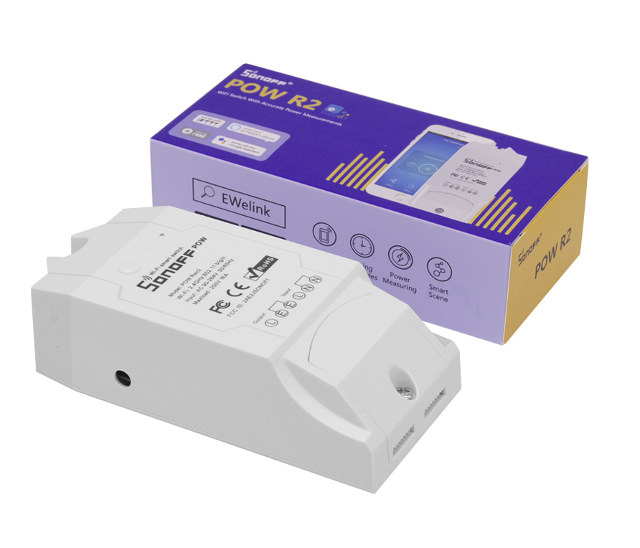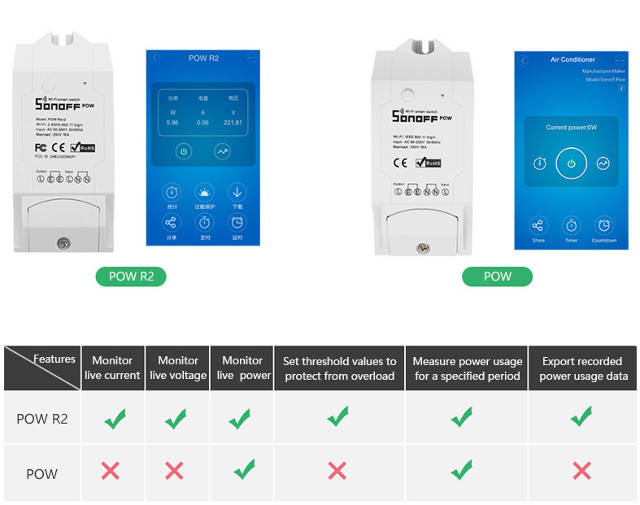ITEAD Studio released several wireless switches / sockets with power monitoring capability over the years. Recently they company launched Sonoff S31 smart socket that plugs directly into your AC socket and does not require any wiring, but earlier they introduced Sonoff Pow that is meant to be connected directly into your circuit via terminals.
ITEAD has now launched an upgrade to the latter – Sonoff Pow R2 – with many of the same features, including support for eWelink, but offering 99% measurement accuracy, overload protection defined by the user, and various other features like the ability to export data.

Sonoff Pow R2 (Revision 2) specifications:
- WiSoC – Espressif ESP8266 (TBC)
- Connectivity – 802.11 b/g/n WiFi with WPA/WPA2 support
- Voltage Range – 90 to 250 VAC input
- Max Current – Up to 16A
- Max Power – 3,500 Watts
- Terminals – 6 terminal for mains and load’s ground, live and neutral signals.
- Misc – LEDs for power and WiFi status, power consumption circuitry with 99% accuracy.
- Dimensions – 114 x 52 x 32mm (Fire-retardant ABS V0 enclosure)
- Weight – 91 grams
- Temperature range – 0 to 40
With eWelink firmware and Android/iOS app, it can be used as a remote control to turn on/off device, monitor energy usage, shows historical energy consumption, act as a programmable timer (up to 8), and more. Sonoff Pow R2 is also compatible with Google Nest, Google Assistant, Amazon Alexa, and IFTT.
New features include the ability to report live current and voltage – instead of just power -, to set user-defined threshold values for overload protection, and to export of up to 100 days of power usage data.
It’s unclear whether the company has kept exposing a 4-pin header to easily flash alternative firmware like Sonoff-Tasmota or ESPurna.
Sonoff Pow R2 can be purchased for $14 plus shipping directly on ITEAD store, but if you prefer the older model, Sonoff Pow is still available for $10.50.

Jean-Luc started CNX Software in 2010 as a part-time endeavor, before quitting his job as a software engineering manager, and starting to write daily news, and reviews full time later in 2011.
Support CNX Software! Donate via cryptocurrencies, become a Patron on Patreon, or purchase goods on Amazon or Aliexpress






And still no UL or other electrical safety certification…
Which in other words means that this is legally not allowed to be connected to mains power in most countries.
It had CE marking, so Euro should be fine (if really tested)
TLDR – CE doesn’t mean a product is electrically safe, as it hasn’t been tested for this.
You’re aware that CE marking means that no electrical safety testing has actually been done, correct?
CE marking is self-certified and simply means that if there’s an issue and your house burns down, the company that made the product is liable. As this is a Chinese company, I’m sure zero F###’s will be given.
This is why a lot of European countries still have their “old fashioned” test labs still going, such as TÜV, SEMKO etc. that still test for electrical safety and allows you to use their logo to show that this test has been done.
In contrast, the US still requires anything being connected to mains power to be UL tested for safety. Admittedly the US electrical safety standards are lower than they used to be in Europe, but these days it’s a higher mark on a product than CE.
CE does require testing for EMI etc. but that’s the same as the FCC certification, which just means that the product shouldn’t interfere with other electronics. Another major flaw with CE, unlike both UL and FCC, is that there’s no database where you can look up a manufacturer of a device. So if you have a problem and want to report it, it might be impossible to find the OEM.
Obviously if you for some reason feel a product is unsafe, you can report this to your local electrical safety government institution and they can then decide to test the product and if they deem it unsafe, they can have it pulled from the EU market. However, this is a time consuming thing to do and might only result in a local ban in your country.
So yeah, don’t read too much into the CE mark on a product, as it doesn’t really mean much.
To complete TLS answer, you may want to check safety standards like “UNE-EN61010-2-03, UNE-EN 61326-1:2006, EN 301 489-17 V2.2.1” which are used in Wibeee @ https://www.cnx-software.com/2018/02/16/wibeee-power-monitoring-device-plugs-right-into-your-homes-circuit-breaker-box/
Correct, but if you have a CE marking you should have at least self certified safety but also emi/emc. Also declaration of conformaty (doc) should be availible, but could not find it. This one should define which safety standard used.
But agree, from a chinese company one should not expect too much. However indeed everyone can place the logo
Also due to the wifi it should have etsi (red) tested, neither could find this one.
They seem to do FCC for the Wi-Fi and EMI on at least some of their products, as point out by CNX is a previous write-up. Even so, that only means that they don’t interfere with other products.
I just feel that companies making products that connect to AC power should do their due diligence and certify them, as there are real dangers.
That said, companies like Fibaro from Poland which makes a range of Z-Wave products have had at least two products pulled from the market, as despite the products apparently being self tested towards CE, they didn’t meet the safety standards. In one case they used 10A screw terminals for a 16A product. In the other case, they’d placed a screw too close to the AC power terminals inside the device so you could technically get electrocuted by the product.
So again to my point above, CE means nothing when it comes to safety, even when a product is supposedly certified. It’s really a rather lousy certification which doesn’t make for safer products.
I had a POW and it melted. Luckily I smelt if before it there was a fire. They use soldered tracks for switching 16A which just isn’t safe. The low power Sonoff units are OK – I wouldn’t put one in a wall though!
I don’t understand what this device do
You wire it up to something that draws electricity and it tells you via an app how much electricity the device is using and you can graph that data over time. Technically you could just add it to an extension cord and not damage whatever appliance you want to use it with. But it might not be entirely safe, as it hasn’t passed electrical safety testing.
apart from what TLS says you can also remotely power on/off your device.
I’m very tempted to order one, but the electrical safety indeed has put me off.
Note that it can also do 5V-24V DC so another use case could be to power a development board.
I once had a case where the board was not at my desk but almost at the other side of the world and I had something like this so I could remotely power cycle the board. Console access was via ser2net or so. Worked like a charm. Just don’t brick the device.
How are you going to switch a DC device with an AC relay?
Actually I was mistaken, it was one of their other devices (the Pro 4CH) which supports both AC and DC.
Technically it can be done. Whatever goes through the relais is not dependent on how the relais is activated/switched. Whatever goes over the contact is independent of how it is steered. It is just a magnetically controlled switch.
In the past I bought the old POW, but now I prefer the SDM120c with modbus output.
https://www.aliexpress.com/item/SDM120C-Single-Phase-Smart-Meter-Pulse-output-RS485-Resetable-17-5mm/1351365296.html
Will the SDM120 work on USA 110 volts AC? I don’t need to monitor 220 volts.
I think that model only supports 220V, but I’ve seen some sellers mention 110V models. Maybe chat with the seller to see if they offer it.